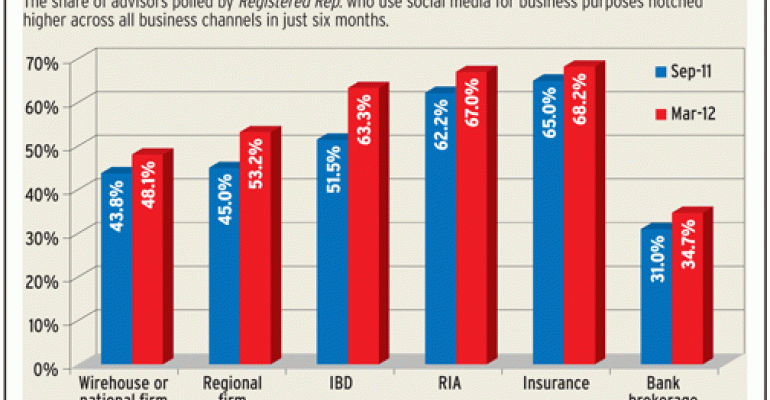Social media is gaining momentum with financial advisors, new research by Registered Rep. and wealthmanagement.com shows. Separate surveys of more than 1,400 Rep. readers in September 2011 and March 2012 showed that the use of social media for business purposes grew in every advisor channel within the six-month period by up to 12 percentage points. (See chart below.)
The brisk pace at which advisors are exploring the new media comes as no surprise to Amy McIlwain, president of Financial Social Media in Denver, Colo., which consults with financial professionals on best practices. McIlwain was driving to a program in Texas recently when she spied a tractor-trailer bearing the message, “Follow us on Facebook and Twitter.”
“I think these financial advisors can’t ignore it any more, and they realize how important it is,” McIlwain says. The bulk of the advisor demographic clusters around their 50s and early 60s, a more technology-challenged audience, she says, “but I’m seeing their eagerness to learn.”
The Rep. report, A Day in the Life of a Financial Advisor: Current and Future Social Media Trends Revealed, found that “networking with other professionals” was by far the biggest business use of social media among the advisors polled, at 43 percent. A distant second was “client prospecting” at 26 percent, followed by “researching new/current clients” at 21 percent.
Given the interest in networking, it’s no surprise that LinkedIn is the most popular site with advisors, with 84 percent saying they use it. Bringing up the rear is Facebook (28 percent) and Twitter (16 percent).
McIlwain and John Philpott, chief executive of Interactive Advisory Software in Marietta, Ga., say that social media use needs to be part of a broader marketing strategy.
The technology is most effectively used to position advisors as financial experts in their community, McIlwain says. Blogs, for example, can help build an audience for the advisor’s views, as long as it’s not pitching products or services. Eventually, she says, strangers become consumers of the advisor’s content, and ultimately they become clients.
Philpott says advisors need to be mindful when using sites such as LinkedIn to prospect. “You don’t want to spam your client base,” he says. “If (clients) start to get a lot of things that are not relevant and are intrusive, that’s when they phase it off. Advisors need to make sure they’re providing relevant content, but also to be respectful of the folks they’re trying to target.”
Data from the Rep. survey suggests that most advisors get it. The technology does not appear to be changing classic game plans for generating clients; while more than one out of five advisors said their first contact with a potential client was through social media, nearly half—45 percent—said their social media connection was a follow-up to a first contact through other means.
And it works. More than one in four advisors who use social media for business purposes have said they landed clients from the effort.
For advisors who avoid social media, compliance issues and unsupportive management are overwhelmingly the chief reasons. Nearly two-thirds of firms bar advisors from using Facebook, YouTube and Twitter, the survey showed, although prohibitions on LinkedIn accounted for just over 25 percent. For advisors who don’t use social media, nearly half blamed “too much compliance and paperwork” as the reason.
Advisors should view the management of social media in the same way that they manage other regulated office practices, Philpott says. Workflow systems, including archiving programs that record interactions on social media, can be automated in ways that are compliant with FINRA regulations, he says.
“The good news for advisors is everyone is working their way through these tools as well—the regulators are, the software providers are, the advisors are,” Philpott says.

For a copy of the research, register here.


